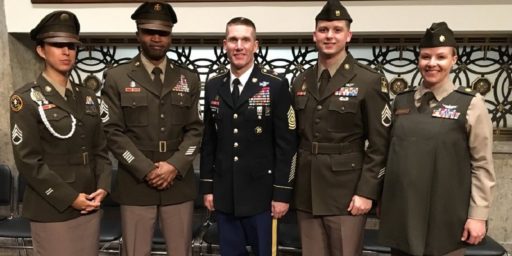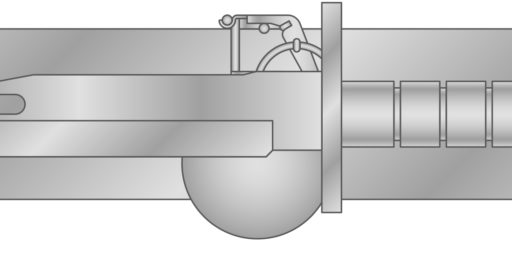New Army Advanced Combat Uniform Review
SFC Thomas Nichols (aka “Jack Army”) passes along some reviews of the Army’s new Advanced Combat Uniform (ACU), which has finally arrived.
A captain complains that the uniform makes him look “replaceable” because of the disapperance of skill badges and other personalized insignia. More significantly, he is concerned about the noisiness of all the velcro.
Nichols hasn’t yet gotten a set of the $80 replacement for the $40 Battle Dress Uniform (BDU) but observes,
[C]hanging uniforms in the middle of a war seems a bit odd to me as well. The desert pattern and the woodland pattern worked well for a few decades, a few more years wouldn’t hurt. I don’t see or hear alot about Soldiers trying to be camouflaged in Baghdad, but then, I haven’t been there so I don’t know. But to my way of thinking, the IED’s don’t care what uniform you’re wearing, or if you’re wearing one at all.
I will say this much, though. War is great for getting new stuff. New uniforms, new electronics, new weapons systems, new armor (body and vehicle), the list goes on. This is a good thing. I’ll put up with some velcro pulling to get a great outfit of body armor.
Indeed. I’m surprised the BDU lasted as long as it has, especially since the NATO-standard woodland camouflage pattern has seemed an odd basic issue uniform for more than a decade. Not a lot of European woods in the places our soldiers have been deploying since the Cold War.
Nichols also comments that there are probably too many skill badges out there, singling out the coveted Air Assault badge:
I learned how to rappel in my SF training. I learned how to ruck in Basic Training. I learned how to tie knots in the period in between. I could learn how to sling load a water buffalo in an hour or less. Why do we have a school and a badge for all that?
As the owner of the Bullwinkle Badge as well as the Basic Parachutist (aka “Airborne”) badge, I would note that the former course is two weeks and the latter three. One actually learns skills at the former whereas one could train a chimp to do a parachute landing fall in about fifteen minutes. Airborne school is basically a couple hours of training interspersed with two weeks of harassment and then five hours of proving that gravity still operates over eastern Alabama interspersed with forty hours of sitting around in heavy equipment.
It’s probably true that someone who has already been through nearly a year of Special Forces training would get little out of Air Assault school; but then, they’d find the Basic NCO Course and Officer Advanced Course rather redundant, too. Like Airborne school, though, the course is designed for people newly assigned or en route to a specialized unit that performs those duties. For others, it’s about gaining a sense of accomplishment and/or getting a shiny merit badge.
Related:





You left out the fun part of Airborne school where you get the pointy parts of your “shiny merit badge” punched into your chest by some gigantic colonel.
Oh, I definately agree that Airborne school is way too long and much more complicated than it needs to be. I think you could easily do it in about 5 days, maybe 6.
I don’t like the NCOES schools. Too little information packed into way too much time. And all the details and cleaning up… I could and did do that at my unit. Why spend weeks doing at some goofy “academy”?
The Army could save a lot of money and some Soldiers’ time by cutting out the crap. Hell, my mother used to say the Army made it’s privates look like Spanish Generalissimos. Most times I have to agree.
And learning to rappel in the SFQC took less than a day. Didn’t need the whole year to get that. Don’t take offense to me singling out the bullwinkle badge. I think there are lots of other badges and ribbons that are superfluous.
But then Napolean said something about a peice of ribbon once…
Yep, I learned rappeling in ROTC long before I went to Air Assault–although actually doing it from a chopper at 100 feet in full gear is much harder than doing it off a tower.
My guess is that the NCOE schools are designed, at least partly, as a break for the soldiers. It’s a chance to get some R&R in a relatively relaxed atmosphere and interact with folks from outside the MOS. Twenty years of nothing but grunt duty is too hard on the psyche, let alone the knees.
We get 30 days of paid vacation per year. That’s break enough. After all, a veteran of 12 years has only worked 11, right?
Most of the NCO’s in my last course (ANCOC) did not want to be there. They were frustrated that the material covered either did not apply to their MOS or that they had been doing those tasks for years already.
I really think that NCOES could use some tweaking.
I was SF/Airborne a looong time ago (how long? – we got some of the first “woodland” camo to test – we told ’em that OD green worked better for us in the woods of Europe).. IMHO, the only reason Airborne school is three weeks is for the physical training.. it seemed like most incoming students needed SERIOUS work getting into “airborne” shape.. I think everybody goes to Airborne School BEFORE they go on to SF, Ranger or whatever.. and you have to start at a pretty high level of conditioning for those schools.
“…you get the pointy parts of your “shiny merit badge†punched into your chest..”
What kind of a big pussy would feel it necessary to complain about a couple of punch holes in his chest?
If you can’t take that, then you’re better off going down the road and not endangering the lives of fellow warriors when the time comes to take some real pain and agony.
re the woodland uniforms, don’t forget we have people in the Phillipines, S America, etc. Plenty of woods there.
Gotta agree with Paul. I do worse than that to myself with a sewing needle on a regular basis.
Is it just me, or etween the collar and everything… does the new uniform basically look like a super-updated version of a caftan? Like the Mongols understood the proper military uniform, and everything else has just been adjustments since then?
Every year after ROTC Advanced Camp at Ft Bragg, 5th SF Gp ran an airborne school for ROTC cadets. It lasted two weeks and was TRADOC certified. One wk ground school and one week jump week, done. No yelling, screaming, etc. PT in the morning, train all day. The SF NCOs teach, not harass. IIRC, this program got yanked by TRADOC in 1988 or so because it wasn’t three weeks like the “real” jump school at Benning.
Don: I remember that course, as I was class of 1988. Unfortunately, I did camp at Riley and missed out. I wound up doing Air Assault as a cadet and Airborne as a 2LT.
Geez Paul/Russ, it was a joke. Lighten up, Francis.
I went through jump school in ’87. While I didn’t jump in Iraq, the LRS company I was in did find that schools like that are often beneficial in building a tight, cohesive unit. The desire to do things like jump out of a moving aircraft attracts a certain type of man that is usually willing to take the extra steps when they’re needed. I have 2 badges: basic jump wings and a CMB to replace my EFMB. I don’t mind the so called “badge collectors”. If it was so easy, everybody would have them.
I went to jump school at Benning the week after Saddam invaded Kuwait. The senior black hats, whose ranks included a number of ‘Nam vets with 101st combat patches, restored the olde skoole standard runs, 5 miles a day, 10 on Fridays, at a blistering, flat-out pace. They told us on day 1 that we were likely to be diverted to the 82d, to serve as replacements and augmentees for the cannon-fodder from Bragg, ergo, the black hats wouldn’t “f*** around” as they usually did. We lost close to 60% of the class. Something tells me we weren’t trained to TRADOC standards. But it was a good way to get rid of a lot of non-hackers. Those who made it through struck me as basically solid, and likely to pass the foxhole test.
Of course nobody rescinded my existing orders, and I wound up in the Gulf with one of the proudest leg (actually mech) divisions in the Army, but at least I had a good story about my olde skoole jump training. And I could run like a scalded cat, which helped me max some PT tests and win sergeants stripes.
As a young man I had one reason and one reason only for going to jump school: Someone told me that “Chicks dig the wings.”
(Then I met a girl with the wings. Hoo-ah.)
Given that civilian jump classes are all of 4 to 6 hours for your basic static line jump, I tend to agree that Jump School is way too long. Now of course, jumping with combat gear is a tad bit different, still this course should be condensed into a week. This isn’t HALO or HAHO
My BNCOC was 2 months long. I’m a 42A. There was no reason for it to go on that long. We’d have eight hours of instruction for something as simple as NCOERs. It was a waste. The only good part about it was the weekends when I’d go down to Rafters in Five Points and… enjoy myself… with a rather attractive classmate of the fairer sex.
I went to Jump School in 1974, when we were still using the T-10s. Made the mistake of showing up on a Friday after 5 p.m. so, I had a zero week. THAT was a waste of time.
The thing about jump school, is that it is not that physically difficult, but it is psychologically very effective. By the end of Tower week, I honestly believed that I was the baddest ass around, and that come Jump week, if both of the chutes failed, that the ground would get out of the way.
First jump cured that notion.
While I’m sure it’s easy to second-guess just about everything the military does, I’m sure that given the mission of the Airborne Corps, if there wasn’t a solid reason for the three weeks of jump school, they’d have scrapped it long ago. Hell, even if that reason is simply “tradition”, those three weeks serve a purpose.
I went to jump school at Benning in ’85, and what was impressed upon me was that we weren’t only being taught to jump, (which apparently a chimp can do), but to jump fully loaded in the dark, with hundreds of other troops suspended in the air at the same time, land without getting injured, and most importantly, not be so freaked out by the experience that you could actually get up and go on to complete your mission. The issue was not just to jump, but to make it something that wasn’t a big deal. The big deal of course, would be the fireworks that followed.
Jump school is a stepping stone to bigger and better things, and a means to weed out those who really aren’t up to the challenge of what might lie ahead.
As for the blood wings, when my Dad, a D-Day vet, pounded mine into my chest with all his might, well, I don’t think I’d have traded that experience for anything. He was waiting on the drop zone for me after my fifth jump. Several of my buddies also requested blood wings from my dad. He was a loadmaster who dropped the 82nd on D-Day and that connection to the history and tradition or the Airborne was part of what made me want to serve in the first place.
Although the legendary history of the American Airborne Soldiers may seem hoky to some of you, lets not forget that it’s that same storied history that makes our enemies crap themselves when they see parachutes in the sky. Rangers, Special Forces, and the 82nd (with thier little “merit badges”) have done a lot for this country.